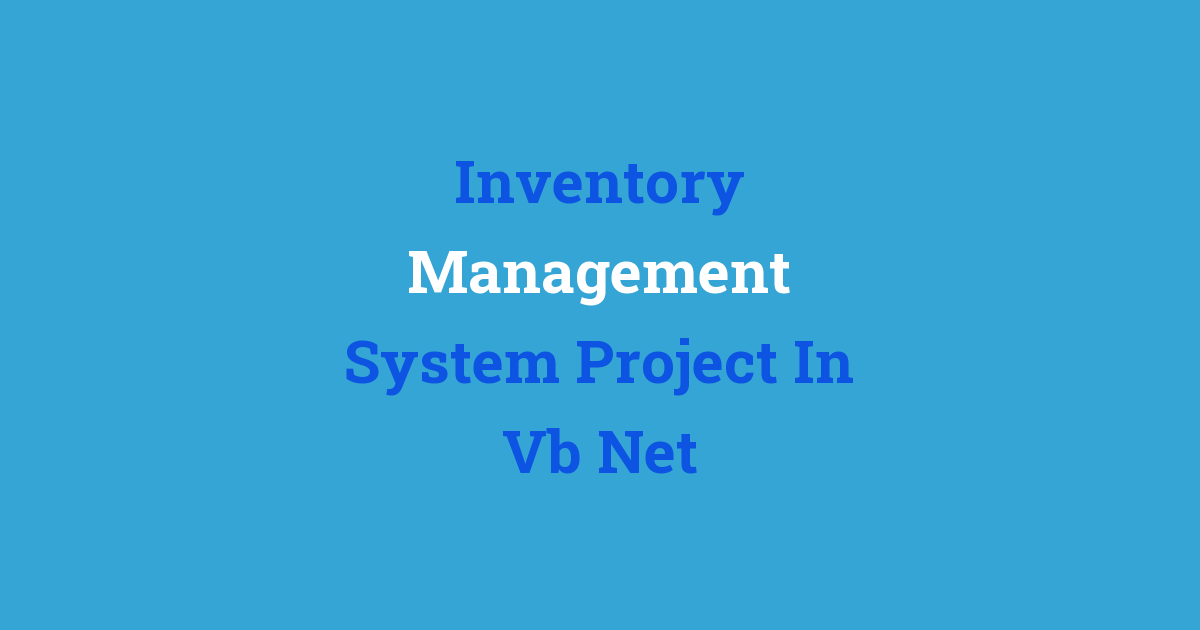Project: Inventory Management System using Visual Basic .NET
Inventory Management System Project in VB.Net
Introduction
In today’s fast-paced business environment, efficient inventory management is crucial for the success of any organization. An Inventory Management System (IMS) is a software solution that helps businesses keep track of their goods and supplies in real-time. This project aims to develop an IMS using Visual Basic .Net (VB.Net) to automate and streamline the inventory management process.
Problem Statement
Many organizations still rely on manual methods or outdated software to manage their inventory. This often leads to inefficiencies, errors, and increased costs. The lack of real-time data and visibility into inventory levels can result in stockouts, overstocks, and lost sales opportunities. Therefore, there is a need for a more advanced and automated IMS to address these challenges.
Existing System
The existing inventory management system in many organizations is manual or partially automated. It typically involves maintaining spreadsheets, paper records, or using basic software applications like Microsoft Excel. These systems are prone to errors, inconsistencies, and inaccuracies due to human intervention. They also lack integration with other business processes and are not scalable to meet the growing needs of the organization.
Disadvantages
Some of the disadvantages of the existing inventory management systems include:
1. Manual data entry leads to errors and inaccuracies.
2. Limited visibility and control over inventory levels.
3. Lack of integration with other business processes.
4. Time-consuming and inefficient inventory management processes.
5. Inability to generate real-time reports and analytics.
6. Inability to track stock movements and monitor reorder levels accurately.
Proposed System
The proposed Inventory Management System project in VB.Net aims to address the shortcomings of the existing systems by providing a more advanced, automated, and integrated solution. The system will offer the following key features:
1. Centralized database to store and manage inventory data.
2. User-friendly interface for easy navigation and data entry.
3. Real-time monitoring of inventory levels and stock movements.
4. Automated alerts and notifications for low stock levels and reorder points.
5. Integration with other business processes such as sales, purchasing, and accounting.
6. Advanced reporting and analytics capabilities for better decision-making.
Advantages
The proposed IMS in VB.Net offers several advantages over the existing systems, including:
1. Improved accuracy and reliability of inventory data.
2. Enhanced visibility and control over inventory levels.
3. Increased efficiency and productivity in inventory management processes.
4. Better integration with other business processes for seamless operations.
5. Real-time reporting and analytics for informed decision-making.
6. Scalability to meet the growing needs of the organization.
Features
Some of the key features of the Inventory Management System project in VB.Net include:
1. Inventory tracking: Keep track of goods and supplies in real-time.
2. Reorder management: Set up reorder points and automate purchase orders.
3. Stock movement: Monitor stock movements and transfers between locations.
4. Reporting and analytics: Generate reports on inventory levels, sales trends, and stock turnover.
5. User management: Assign roles and permissions to users based on their responsibilities.
6. Data import/export: Import and export inventory data in different file formats.
Conclusion
In conclusion, the Inventory Management System project in VB.Net is a comprehensive solution to address the challenges faced by organizations in managing their inventory effectively. By automating and streamlining the inventory management process, the system can help businesses improve efficiency, accuracy, and productivity. With its advanced features and capabilities, the IMS in VB.Net is poised to revolutionize the way organizations manage their inventory and drive success in their operations.

